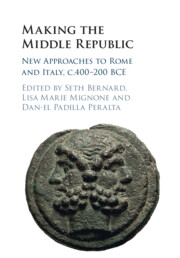Book contents
- Making the Middle Republic
- Making the Middle Republic
- Copyright page
- Contents
- Figures
- Tables
- Charts
- Contributors
- Acknowledgments
- Maps
- 1 Introduction
- Part I Historical Sources
- Part II Material Sources
- 6 The Strangeness of Rome’s Early Heavy Bronze Coinage
- 7 Rural Transformations in Middle Republican Central Italy
- 8 Towards an Agroecology of the Roman Expansion
- Part III Architecture and Art
- Conclusion
- Bibliography
- Index
8 - Towards an Agroecology of the Roman Expansion
Republican Agriculture and Animal Husbandry in Context
from Part II - Material Sources
Published online by Cambridge University Press: 20 April 2023
- Making the Middle Republic
- Making the Middle Republic
- Copyright page
- Contents
- Figures
- Tables
- Charts
- Contributors
- Acknowledgments
- Maps
- 1 Introduction
- Part I Historical Sources
- Part II Material Sources
- 6 The Strangeness of Rome’s Early Heavy Bronze Coinage
- 7 Rural Transformations in Middle Republican Central Italy
- 8 Towards an Agroecology of the Roman Expansion
- Part III Architecture and Art
- Conclusion
- Bibliography
- Index
Summary
A significant increase in agricultural production underpinned the many socioeconomic transformations that define first-millennium-BCE Italy. However, the farming regimes that underpinned this rise in surplus production, and its evolution through Republican times, are poorly defined. This lack of clarity is problematic, because cultivation and herding practices dictated the relative value of land versus labur. Without good archaeological data on this fundamental area of the Republican economy, we are ill-equipped to address central questions of land use, investment, and the motivation for territorial expansion in the Middle Republican period. This chapter argues for the importance of farming regimes as a force that shaped Roman social and economic history, and provides a first step towards an agroecology of the Roman expansion. It presents a new synthesis of archaeobotanical and zooarchaeological data integrated with wider evidence for agricultural processing and rural production. This analysis places bioarchaeological evidence for Republican farming in its peninsular context for the first time. Results indicate that production was motivated more by regional trajectories than by Roman annexation, and that rural settlement changes did not have a major immediate impact on the bioarchaeological data considered here. Lastly, we highlight key points of change alongside pathways for future research.
Keywords
- Type
- Chapter
- Information
- Making the Middle RepublicNew Approaches to Rome and Italy, c.400-200 BCE, pp. 164 - 190Publisher: Cambridge University PressPrint publication year: 2023
- 3
- Cited by

